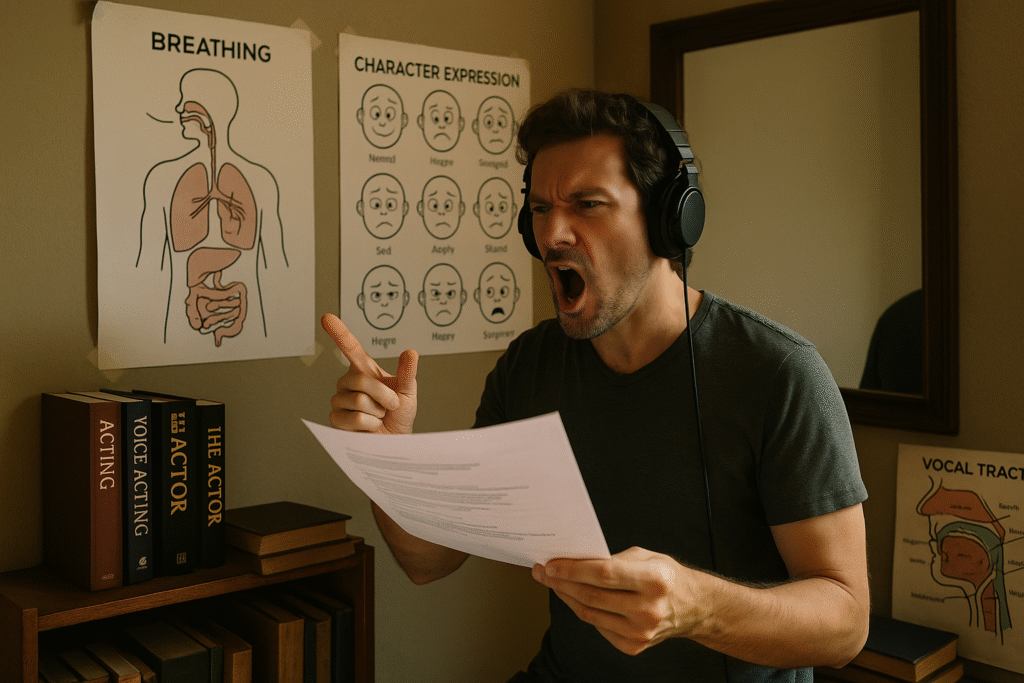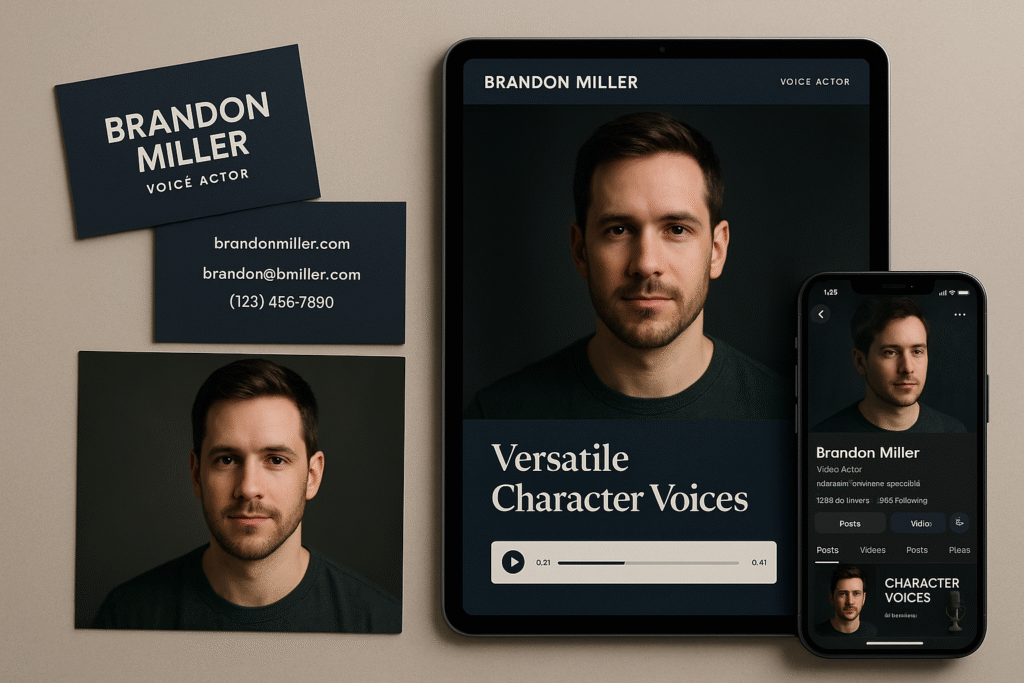In a world increasingly filled with audiobooks, animated content, video games, and commercial media, the demand for talented voice actors has never been higher. Voice acting represents an exciting career path that combines creativity, technical skill, and business savvy—all without requiring you to appear on camera. Whether you’re captivated by the idea of bringing characters to life, narrating compelling stories, or lending your voice to commercials that reach millions, this comprehensive guide will walk you through everything you need to know to build a successful and financially rewarding voice acting career.
Understanding the Voice Acting Landscape

The voice acting industry encompasses a diverse range of opportunities spanning multiple sectors, each with its own requirements, pay scales, and working conditions. Before diving in, it’s crucial to understand the landscape you’re entering.
Major Voice Acting Markets
Commercial Advertising: From local radio spots to national television campaigns, commercial work forms the bread and butter for many voice actors. These jobs typically pay well for short sessions, with possibilities for residual payments when ads continue to air.
Animation: Voicing characters for animated films, television shows, and web series requires exceptional character development skills and emotional range. While highly competitive, animation roles can provide steady work through recurring characters and potentially lead to fan recognition.
Video Games: The gaming industry has exploded in recent decades, creating enormous demand for voice talent. Gaming work often involves intense emotional performances, combat vocalizations, and bringing complex characters to life across storylines that might span multiple titles.
Audiobooks: The fastest-growing segment of publishing, audiobook narration demands stamina, consistency, and the ability to portray multiple characters while maintaining narrative flow. Compensation models typically involve per-finished-hour rates or royalty sharing arrangements.
Corporate Narration: E-learning modules, training videos, corporate presentations, and phone systems all require professional voice work. Though less glamorous than entertainment roles, corporate narration often provides reliable, well-paying work with repeat clients.
Documentary Narration: Bringing factual programming to life requires a voice of authority, clarity, and appropriate emotional connection to subject matter. This specialty combines performance with educational communication.
Industry Structure
The voice acting world operates through several interconnected channels:
Union Work: In the United States, the Screen Actors Guild-American Federation of Television and Radio Artists (SAG-AFTRA) represents professional voice actors, establishing minimum rates and providing benefits. Union jobs typically offer better compensation but require membership and adherence to union rules.
Non-Union Work: Many opportunities exist outside union jurisdiction, particularly for beginners. Non-union work provides valuable experience but may offer less protection regarding payment terms and working conditions.
Agency Representation: Talent agencies connect voice actors with clients, handling negotiations and administrative details in exchange for a percentage of earnings (typically 10-20%). Reputable agencies only take commission when you work, never charging upfront fees.
Direct Marketing: Many voice actors, especially when starting out, find work by marketing themselves directly to potential clients through personal websites, social media, and freelance platforms.
Understanding these fundamental structures will help you navigate the industry more effectively as you develop your career strategy.
Assessing Your Natural Abilities

Before investing significant time and resources into voice acting, it’s important to honestly evaluate your natural vocal qualities and aptitudes. While training can dramatically improve your abilities, certain fundamental characteristics will influence your career path.
Vocal Assessment
Take time to analyze your voice objectively:
Vocal Range: Record yourself reading various texts and listen for your natural pitch range. Can you comfortably speak higher or lower than your conversational voice? A broader range opens more character possibilities.
Tone Quality: Is your natural voice warm or cool? Smooth or textured? Authoritative or friendly? Understanding your natural tone helps identify your initial strengths.
Stamina: Can you speak clearly for extended periods without vocal fatigue? Audiobook narration often requires 4-6 hours of continuous recording daily.
Accent and Dialect Capabilities: What is your natural accent? Can you authentically produce other regional or international accents? Versatility with accents can significantly expand your marketability.
Character Voices: Without formal training, try creating distinct character voices. This tests your innate ability to transform your voice into different personas.
Aptitude for Performance
Voice acting is still acting, requiring performance skills beyond just speaking:
Emotional Range: Can you convey emotions convincingly through your voice alone? Try recording the same sentence expressing joy, anger, fear, and sadness.
Reading Fluency: How smoothly can you read unfamiliar text aloud? Do you stumble over complex words or struggle with pronunciation?
Imagination: Can you visualize scenarios and respond authentically? This creativity fuels compelling voice performances.
Direction Response: How well do you incorporate feedback? Voice actors must quickly adjust their performance based on director guidance.
Analysis Skills: Can you break down a script to understand subtext, character motivation, and appropriate delivery style?
Technical Inclination
Modern voice actors must be technically self-sufficient:
Audio Technology Comfort: How comfortable are you learning new software and equipment? Are you willing to troubleshoot technical issues?
Editing Aptitude: Basic audio editing skills are increasingly expected of voice actors, especially for remote work.
Home Studio Management: Are you prepared to create and maintain a recording environment that meets professional standards?
This self-assessment isn’t about finding limitations but identifying your starting point and natural strengths. Every voice actor has a unique “signature sound” and specialties that make them castable. Understanding yours helps target appropriate training and initial market positioning.
Essential Skills Development

Voice acting combines artistic expression with technical proficiency. Developing these core skills will prepare you for professional opportunities and help you deliver consistently excellent performances.
Acting Fundamentals
At its heart, voice acting is acting—just without visual components:
Script Analysis: Learn to break down scripts for meaning, subtext, and character motivations. Understanding what’s beneath the words informs how you deliver them.
Character Development: Practice creating distinct characters with unique vocal qualities, speech patterns, and emotional perspectives. Keep a “character journal” documenting different voices you develop.
Emotional Truth: Work on accessing genuine emotions quickly and conveying them authentically through your voice. Technique without truthfulness sounds hollow.
Microphone Acting: Unlike stage or screen acting, voice performance requires adjusting your physical expression to focus energy into your voice. Practice conveying physical actions and reactions using only vocal cues.
Voice and Speech Training
Your voice is your instrument, and like any instrument, it requires proper technique:
Breath Control: Develop diaphragmatic breathing techniques that support sustained speech and prevent vocal fatigue. Practice reading full paragraphs on a single breath while maintaining consistent volume.
Articulation: Clear pronunciation ensures your performance is understood. Practice tongue twisters and difficult sound combinations daily to improve muscle memory.
Vocal Health: Learn proper vocal warm-ups and cool-downs, hydration practices, and how to protect your voice during demanding sessions. Your voice is your livelihood—treat it accordingly.
Vocal Variety: Expand your range through targeted exercises addressing pitch, pace, power, and tone. Record yourself reading the same passage with different emotional intentions and technical adjustments.
Specialized Techniques
Different voice acting niches require specialized skills:
Commercial Delivery: Practice the conversational yet compelling delivery style that advertising demands, emphasizing benefits while sounding authentic rather than “sales-y.”
Character Voices: Develop sustainable techniques for creating distinct character voices without strain. Focus on changes in placement (where the voice resonates), rhythm, and emotional perspective rather than just pitch manipulation.
Long-Form Narration: Build stamina and consistency for audiobook and documentary work through extended reading sessions. Practice maintaining character voices and narrative tone across multiple recording sessions.
Video Game Combat: Learn techniques for recording effort sounds, battle cries, and death scenes that sound authentic without damaging your vocal cords.
Technical Skills
Today’s voice actors need technical proficiency:
Recording Software: Become comfortable with digital audio workstations (DAWs) like Audacity (free), Adobe Audition, or Reaper. Learn basic functions including recording, editing, and exporting files in different formats.
Audio Editing: Develop skills in removing mistakes, reducing noise, and meeting technical specifications for different clients. Practice “punch and roll” techniques for efficient correction of errors while recording.
File Management: Create an organized system for naming, storing, and backing up audio files and scripts. Develop a workflow that allows quick retrieval of past work.
Professional Development Resources
Accelerate your skill development through structured learning:
Voice Acting Coaches: Individual coaching provides personalized feedback crucial for rapid improvement. Look for coaches specializing in your areas of interest.
Acting Classes: General acting classes build foundational skills transferable to voice work. Improvisation classes are particularly valuable for developing spontaneity and character work.
Online Courses: Platforms like Edge Studio, Such A Voice, and Voice123 offer structured voice acting curriculums with progressive skill development.
Practice Groups: Join or form groups where actors read scripts together and provide feedback. These communities offer both skill development and networking opportunities.
Workshops: Attend workshops with casting directors, agents, and successful voice actors to gain industry insights alongside technical training.
Remember that skill development in voice acting is ongoing throughout your career. Even established professionals continue training, exploring new techniques, and expanding their capabilities. Budget both time and money for continuing education as part of your career plan.
Building Your Home Studio

In today’s voice acting landscape, having a quality home recording setup isn’t optional—it’s essential. Your home studio will serve as both your practice space and your primary workplace for remote sessions and auditions. Creating an effective recording environment requires balancing acoustics, equipment quality, and budget constraints.
Location Selection
Before purchasing equipment, find the right space in your home:
Room Characteristics: Look for a quiet room away from external noise sources (traffic, neighbors, household activity). Smaller rooms are generally easier to treat acoustically than large, echoey spaces.
Background Noise Assessment: Listen carefully for HVAC systems, refrigerators, plumbing noise, and other household sounds that might interfere with recording. Use your smartphone to record several minutes of “silence” in potential locations to identify noise issues.
Isolation Considerations: If possible, choose a room without shared walls with noise-generating spaces. Closets often make excellent improvised studios due to clothing’s sound-absorbing properties.
Acoustic Treatment
Even with quality equipment, poor room acoustics will ruin recordings:
Sound Absorption: Reduce echoes and reverberations using acoustic foam panels, bass traps for corners, and acoustic blankets. Strategic placement is more important than quantity—focus on treating early reflection points where sound bounces off walls before reaching your microphone.
DIY Options: Budget-friendly alternatives include hanging moving blankets, creating book-filled shelves, using thick curtains, or building PVC-framed reflection filters covered with acoustic materials.
Portable Solutions: For those unable to permanently modify their space, consider portable vocal booths or reflection shields that create a controlled environment around the microphone.
Floor Treatment: Place carpet, rugs, or acoustic mats beneath your recording position to reduce reflections from hard floors.
Essential Equipment
The core components of any home studio include:
Microphone: Your most important investment. For beginners, a quality USB condenser microphone like the Audio-Technica AT2020USB+ or Blue Yeti provides good results without requiring additional hardware. As you advance, consider XLR microphones like the Rode NT1 or Neumann TLM 103, which offer superior sound but require an audio interface.
Pop Filter: This inexpensive screen reduces plosive sounds (hard P and B sounds) that can distort recordings. Position it 2-3 inches from your microphone.
Microphone Stand: A stable stand prevents handling noise and maintains consistent microphone position. Desktop stands work for seated recording; boom arms offer more flexibility and reduce desk vibrations.
Headphones: Closed-back studio headphones like the Sony MDR-7506 or Beyerdynamic DT 770 Pro allow you to monitor your performance without sound leakage that could be picked up by your microphone.
Computer: Any modern computer with sufficient processing power and minimal fan noise will work. Consider using an external hard drive for recording to reduce computer noise and improve performance.
Advanced Setup Components
As your career progresses, consider these upgrades:
Audio Interface: Devices like the Focusrite Scarlett series convert analog microphone signals to digital information your computer can process. They provide better sound quality and lower latency than USB microphones.
Acoustic Treatments: Commercial bass traps, diffusers, and absorption panels provide more effective treatment than DIY solutions, particularly for low-frequency control.
Preamps: External microphone preamps like the dbx 286s or FetHead can enhance recording quality by amplifying your microphone signal with minimal noise.
Backup Systems: Uninterruptible power supplies prevent recording loss during power fluctuations; external drives or cloud services back up finished work.
Studio Setup Considerations
Creating a functional workspace involves more than just equipment:
Ergonomics: Position your equipment to allow comfortable recording sessions without strain. Standing desks offer flexibility for both seated and standing performances.
Script Display: Develop a system for displaying scripts that doesn’t create paper noise. Tablets or secondary monitors work well but ensure they don’t generate fan noise.
Lighting: Proper lighting reduces eye strain during long sessions and helps maintain energy levels. Natural light sources can improve mood but may introduce unwanted ambient noise.
Organization: Create dedicated storage for accessories, cables, and reference materials. Keeping your space organized saves time during sessions and auditions.
Testing and Calibration
Before considering your studio complete:
Room Tone Test: Record 30 seconds of silence and listen carefully with headphones for background noise, computer fans, or room resonance that needs addressing.
Voice Test: Record yourself reading at different volumes and distances from the microphone to find your optimal recording position.
Client-Ready Test: Create a sample recording using your complete setup and have an experienced voice actor or audio engineer evaluate the sound quality. Online forums can provide feedback if you don’t have direct connections.
Remember that your home studio will evolve as your career develops. Start with the essentials that deliver professional-quality recordings, then upgrade strategically as your income and requirements grow. The most expensive setup isn’t always necessary—proper technique and acoustic treatment often matter more than premium equipment.
Creating Your Demo Reel

Your demo reel serves as your audio business card—a concise showcase of your best voice work that demonstrates your range, style, and marketability to potential clients. Creating an effective demo requires careful planning, quality production, and strategic content selection.
Types of Demo Reels
Different voice acting sectors require specialized demos:
Commercial Demo: Showcases your ability to sell products and services with authenticity and persuasiveness. Typically 60-90 seconds total, featuring 5-7 distinct commercial styles.
Character Demo: Displays your range of character voices and performance styles for animation and gaming. Usually 60-120 seconds, featuring 6-10 distinct character performances.
Narration Demo: Demonstrates your ability to sustain engaging delivery for documentaries, corporate videos, e-learning, and similar long-form content. Typically 90-120 seconds with 4-6 different styles or tones.
Audiobook Demo: Features narrative passages and character dialogues from various book genres. Usually 2-3 minutes, showcasing consistent narration and character differentiation abilities.
IVR/Telephony Demo: Highlights clear, friendly delivery for phone systems, on-hold messages, and announcements. Generally 60-90 seconds with various prompts and announcements.
When starting out, focus on creating one exceptional demo in your strongest category rather than producing multiple mediocre ones. As your skills and experience grow, expand your demo portfolio to target different markets.
Demo Content Planning
Effective demos require careful content selection:
Market Research: Listen to professional demos in your target specialty. Note length, variety, and production quality standards. Casting directors can detect when you’re copying others, so develop your own approach while respecting industry norms.
Script Selection: For commercial and narration demos, use actual commercial copy or write original scripts that sound authentic—never use copyrighted material without permission. For character demos, write brief scenarios that quickly establish character and emotional situation.
Sequence Planning: Arrange your strongest performance first to grab attention immediately. Create a flow between segments that demonstrates range without jarring transitions. End with another strong piece that reinforces your core strengths.
Length Consideration: Respect industry standards for demo length. Casting directors and agents typically decide within the first 10-15 seconds whether to continue listening, so brevity and quality trump comprehensiveness.
Production Options
Creating a professional-quality demo requires excellent production values:
Professional Production: For your first demo, professional production is strongly recommended. Demo producers specialize in directing performances, editing seamlessly, adding appropriate music and effects, and ensuring consistent audio quality. Expect to invest $300-1,500 depending on your market.
Self-Production: If you have audio engineering experience and exceptional equipment, self-production becomes viable. Be brutally honest about whether your production skills match industry standards—a poorly produced demo can harm your career more than having no demo.
Hybrid Approach: Record raw audio at home, then hire a professional engineer to mix, master, and add production elements. This reduces costs while ensuring professional quality.
Recording Your Demo
Whether working with a producer or creating your own demo:
Preparation: Thoroughly rehearse all scripts before recording. Mark breathing points, emphasis, and character notes on your copy.
Warm-Up: Complete vocal warm-ups before recording to ensure your voice is flexible and responsive.
Multiple Takes: Record several versions of each segment with different interpretations. This provides options during editing and ensures you capture your best performance.
Direction: If possible, work with a director who can provide objective feedback and guide your performance. This outside perspective is invaluable for achieving professional results.
Technical Excellence: Ensure consistent audio quality throughout all segments. Differences in recording quality between segments are immediately noticeable to professionals.
Post-Production Elements
Professional demos incorporate these production elements:
Music Beds: Subtle background music appropriate to the content enhances the professional feel without distracting from your voice.
Sound Effects: Minimal sound effects can help establish context for character or commercial demos, but should never overshadow your performance.
Transitions: Smooth transitions between segments maintain professionalism and show attention to detail.
Mastering: Professional audio mastering ensures consistent volume levels and tonal balance throughout the demo.
Demo Distribution Strategy
Once completed, implement a strategic approach to demo distribution:
Digital Formats: Create both high-quality WAV files for direct submissions and compressed MP3 files for email and website use.
Online Presence: Feature your demo prominently on your website and voice acting profiles on casting platforms.
Targeted Submission: Rather than mass distribution, send your demo to specific agents, casting directors, and production companies that work in your specialty areas.
Updated Versions: Plan to refresh your demo every 1-2 years as your skills develop and market trends evolve. Replace segments that generate less response with new material showcasing your current capabilities.
Remember that your demo should represent work you can consistently deliver in actual sessions. Avoid including character voices or techniques you cannot reliably reproduce under pressure. Authenticity and consistency will serve your career better than showcasing unsustainable skills.
Developing Your Brand

In the competitive voice acting marketplace, a clear, consistent brand helps you stand out and attracts clients who need exactly what you offer. Your brand encompasses your vocal identity, marketing materials, online presence, and professional reputation.
Identifying Your Unique Selling Proposition
Before creating branding materials, define what makes you distinctive:
Vocal Analysis: Identify the natural qualities that make your voice recognizable and marketable. Is it warm, authoritative, youthful, quirky, or trustworthy? These inherent characteristics form the foundation of your brand.
Specialty Areas: Determine where your voice and skills best fit in the marketplace. While versatility has value, focusing on specific niches where you excel creates a stronger initial brand position.
Target Markets: Research which industries and clients need your particular vocal qualities. A youthful, energetic voice might target youth-oriented brands, while an authoritative tone might pursue corporate and documentary work.
Competitive Analysis: Study voice actors with similar qualities to identify how you can differentiate yourself. This isn’t about imitating others but finding your unique space in the market.
Creating Your Brand Identity
Translate your unique selling proposition into tangible brand elements:
Brand Name: Decide whether to use your legal name or a memorable professional name. Ensure it’s easy to spell, pronounce, and remember. Check domain availability before finalizing.
Visual Identity: Develop a simple logo, consistent color scheme, and typography that reflect your vocal qualities. A warm, conversational voice might use friendly colors and rounded fonts, while an authoritative voice might employ more formal design elements.
Tagline: Create a concise phrase that communicates your core vocal offering. Examples might include “The Friendly Authority Voice” or “Bringing Characters to Life Since 2020.”
Brand Voice: Establish a consistent writing style for all your communications that aligns with your vocal brand. Your emails, social media posts, and website copy should reflect the same personality clients will hear in your recordings.
Building Your Online Presence
In today’s market, your digital footprint is critical:
Professional Website: Create a clean, mobile-friendly website featuring your demos, biography, services, and contact information. Keep navigation simple and ensure audio samples play easily across all devices.
SEO Strategy: Research keywords potential clients use when searching for voice talent. Incorporate these naturally into your website content to improve search visibility.
Social Media Presence: Establish profiles on platforms where your target clients spend time. For corporate work, LinkedIn may be primary; for animation, Instagram or TikTok might better showcase your character abilities.
Content Strategy: Regularly share relevant content that demonstrates your expertise and personality. This might include behind-the-scenes recording videos, vocal tips, project announcements, or industry insights.
Email Newsletter: Consider creating a simple newsletter to maintain relationships with past clients and connections, sharing your availability, new demos, and professional developments.
Networking and Relationship Building
Your brand exists in the minds of others as much as in your marketing materials:
Industry Connections: Join voice acting communities, forums, and professional organizations like World Voices Organization (WoVO) or the Voice Over Network. Participate genuinely rather than just self-promoting.
Referral Network: Develop relationships with complementary professionals like audio engineers, producers, and other voice actors with different specialties. Referrals often provide the highest quality opportunities.
Client Relationships: Create systems for following up with clients, requesting testimonials, and maintaining long-term connections. Repeat business forms the backbone of a sustainable career.
Mentorship: Both receiving and eventually providing mentorship enhances your professional standing and expands your network.
Professional Materials
Support your brand with these essential tools:
Business Cards: Despite digital networking, physical cards remain useful at in-person events. Include QR codes linking to your demos for immediate access.
Email Signature: Create a professional signature with links to your website and demo reel. This turns every email into a marketing opportunity.
Proposal Templates: Develop customizable templates for project proposals that maintain consistent branding while addressing specific client needs.
Thank You Notes: Prepare branded templates for post-project appreciation messages. These small touches build memorability and relationship strength.
Brand Consistency and Evolution
Managing your brand is an ongoing process:
Consistency Audit: Periodically review all your materials and online presence to ensure brand consistency across platforms. Inconsistency creates confusion and diminishes professionalism.
Feedback Collection: Regularly ask clients why they chose you and what they value about working with you. This feedback reveals how your brand is actually perceived.
Strategic Evolution: As your skills and market position develop, evolve your brand intentionally rather than drastically changing direction. Gradual refinement maintains recognition while allowing growth.
Market Adaptation: Stay attuned to industry trends and client needs, adjusting your positioning to remain relevant without abandoning your core identity.
Remember that branding isn’t about creating a false persona but about authentically communicating your strengths in a way that resonates with potential clients. The most effective voice acting brands are built on genuine vocal qualities and capabilities, packaged in a clear, consistent presentation that makes hiring decisions easy for clients.
Finding Work: Platforms and Strategies

Building a sustainable voice acting career requires a multi-faceted approach to finding opportunities. Different strategies work better at different career stages, and combining methods creates a more stable workflow. Here’s how to implement effective job-finding strategies across various channels.
Online Casting Platforms
These platforms connect voice actors directly with clients seeking talent:
Major Platforms: Sites like Voice123, Voices.com, Bodalgo, and ACX (for audiobooks) host thousands of projects. Create complete profiles with professional photos, detailed descriptions of your capabilities, and high-quality demos.
Membership Considerations: Some platforms require subscription fees ($300-500 annually) while others take commission from projects. Evaluate the return on investment by researching how many jobs in your specialty appear monthly.
Audition Strategy: Be selective about auditions to prevent burnout. Focus on projects matching your strengths and offering appropriate compensation. Customize each audition rather than sending generic submissions.
Profile Optimization: Update your profiles regularly with new demos, testimonials, and completed projects. Many platforms use activity levels and profile completeness in their algorithms for presenting talent to clients.
Ratings and Reviews: Exceptional service on early projects builds positive reviews that significantly impact your visibility and booking rate on most platforms.
Direct Marketing
Proactively reaching potential clients bypasses competition on platforms:
Target List Creation: Research companies likely to need your specific voice type and specialties. Look for businesses producing content regularly in your target industries.
Personalized Outreach: Send customized emails demonstrating knowledge of the recipient’s work and specific ways your voice could enhance their projects. Avoid generic mass mailings, which rarely succeed.
Follow-Up System: Develop a non-intrusive follow-up schedule (typically 1-2 weeks after initial contact) to increase response rates without becoming annoying.
Value-First Approach: Share useful industry information, congratulate companies on successful campaigns, or offer brief complimentary recordings for specific uses. Building relationships before pitching services increases success rates.
Referral Requests: After successful projects, ask satisfied clients for introductions to others who might need similar services. Provide specific language they can use when making referrals.
Social Media Strategies
Strategic social media presence can generate leads and visibility:
Platform Selection: Focus on platforms where your target clients spend time rather than trying to maintain presence everywhere. LinkedIn works well for corporate clients; Instagram and TikTok can showcase character versatility.
Content Calendar: Create a sustainable schedule for posting relevant, valuable content that demonstrates your expertise without constant self-promotion.
Engagement Focus: Spend more time meaningfully engaging with potential clients’ content than promoting your own. Thoughtful comments build relationships more effectively than broadcast messaging.
Hashtag Research: Identify industry-specific hashtags that potential clients follow, and incorporate them naturally into relevant posts.
Behind-the-Scenes Content: Share your process, studio setup, and project highlights (with client permission). This content humanizes your brand and educates potential clients about voice acting value.
Networking for Opportunities
In-person and virtual networking remain powerful job-finding methods:
Industry Events: Attend conferences like VO Atlanta, One Voice, and local meetups where clients and casting professionals gather. Prepare a brief, memorable introduction focusing on how you solve client problems.
Production Company Connections: Build relationships with audio production houses, animation studios, and advertising agencies that regularly need voice talent. These companies often have ongoing needs and prefer working with familiar voices.
Complementary Professionals: Network with non-competing professionals serving the same clients, such as video producers, copywriters, and marketing agencies. These connections often generate referrals.
Voice Actor Community: Join voice actor groups not just for job leads but for professional development, emotional support, and industry intelligence. Other actors often pass along opportunities that don’t fit their specialty.
Local Market Opportunities
Don’t overlook opportunities in your geographic area:
Local Businesses: Small and medium businesses in your region often need voice work for phone systems, radio commercials, and training materials. These projects may pay less than national work but offer valuable credits and relationship-building opportunities.
Regional Advertising Agencies: Mid-sized agencies frequently need voice talent for local and regional campaigns. Research and connect with creative directors and production managers at these firms.
Educational Institutions: Colleges, universities, and training organizations regularly produce e-learning content requiring narration. Contact their media production departments directly.
Local Media: Radio stations, television channels, and podcast networks need voice talent for commercials, promotions, and special projects. Build relationships with production directors at these outlets.
Industry-Specific Strategies
Different voice acting sectors require tailored approaches:
Animation and Gaming: Follow studios and directors on social media, attend industry conventions, and join specialized casting sites like The Voice Realm that focus on character work.
Audiobooks: Beyond ACX (Audiobook Creation Exchange), connect with independent publishers, attend book fairs, and contact authors directly about producing their audiobooks.
Corporate/E-Learning: Connect with training departments at large corporations, e-learning development companies, and corporate communication agencies. Demonstrate knowledge of their specific communication challenges.
Commercial Advertising: Research advertising agencies handling campaigns for brands matching your voice type. Follow creative directors and producers on LinkedIn and engage meaningfully with their content.
Remember that building a voice acting career is a marathon, not a sprint. Successful voice actors typically use multiple methods simultaneously, adjusting their strategy as they discover which channels yield the best results for their particular voice and specialties. Tracking your marketing efforts and results helps refine your approach over time, focusing energy where it generates the greatest return.
Working with Agents and Casting Directors

As your voice acting career advances, professional relationships with agents and casting directors become increasingly important for accessing higher-paying opportunities. Understanding how these relationships work helps you approach them strategically and maintain them effectively.
The Role of Voice Acting Agents
Agents serve as intermediaries between talent and clients:
Opportunity Access: Agents receive casting notices not available to the general public, particularly for major brands, network projects, and union work.
Negotiation Support: Professional agents negotiate rates, usage rights, and contract terms, often securing better compensation than talent could independently.
Career Guidance: Experienced agents provide strategic advice on demo development, skill improvement, and career trajectory based on market trends and your specific abilities.
Administrative Handling: Agents manage paperwork, follow up on payments, and handle client communication, freeing you to focus on performance.
Industry Connections: Established agencies have relationships with production companies, casting directors, and studios built over years or decades that would be difficult to develop independently.
Finding and Securing Agency Representation
Agency representation requires strategic approach:
Research Appropriate Agencies: Identify agencies representing voice actors at your career level and in your specialties. Look for agencies with clients in sectors where your voice would be marketable.
Submission Preparation: Review agency submission guidelines carefully—these vary significantly. Typically, you’ll need professional demos, a resume of relevant experience, and a professional headshot.
Referral Advantage: Recommendations from industry professionals connected to the agency dramatically increase consideration chances. Before cold-submitting, explore your network for potential connections.
Showcase Marketability: In submission materials, emphasize bookings, special skills, and qualities that make you immediately castable rather than focusing solely on training or potential.
Follow-Up Protocol: After submitting, follow agency-specific guidelines for follow-up. Typically, a single follow-up email or call after 2-3 weeks is appropriate; excessive contact can harm your chances.
Showcase Growth: If initially rejected, continue developing your skills and credits before approaching the same agency again, typically waiting 6-12 months and highlighting specific growth or new major credits.
Understanding Casting Directors
Casting directors serve different functions than agents:
Project Gatekeepers: Casting directors pre-screen talent for directors and producers, selecting appropriate voices for consideration based on project requirements.
Vision Interpreters: They translate creative directors’ sometimes vague requests into specific voice qualities and performance directions.
Talent Advocates: When they discover voices they trust, casting directors often recommend them across multiple projects and to other industry professionals.
Efficiency Experts: Casting directors value talent who take direction well, work efficiently, and solve problems rather than creating them during sessions.
Building Relationships with Casting Directors
Effective relationships with casting directors develop over time:
Research Background: Before meeting casting directors, research their past projects and casting preferences to understand their aesthetic and professional needs.
Audition Excellence: Consistently deliver professional-quality auditions following all instructions precisely. Casting directors remember both exceptional performances and problematic ones.
Session Professionalism: During recording sessions, arrive early, take direction gracefully, offer options without being asked, and maintain positive energy regardless of challenges.
Appropriate Follow-Up: After sessions, send brief thank-you notes without expecting immediate additional work. Build the relationship gradually rather than explicitly asking for more opportunities.
Industry Events: Attend workshops, panels, and networking events where casting directors participate. These provide opportunities for face-to-face connections outside audition pressure.
Social Media Engagement: Follow casting directors’ professional social media accounts and engage thoughtfully with content related to their projects or industry observations—never with generic flattery.
Agent Relationships: Rights and Responsibilities
Working with agents involves mutual obligations:
Exclusivity Understanding: Clarify whether your agreement is exclusive (all work must go through the agent) or non-exclusive (you can self-market for certain work types). Most major market agents require exclusivity.
Commission Structure: Standard agency commission ranges from 10-20% depending on market, work type, and services provided. Understand exactly which services warrant commission and which don’t.
Communication Expectations: Establish clear protocols for availability notification, audition responses, and general updates. Reliable, prompt communication is crucial for maintaining effective agency relationships.
Booking Notification: Inform your agent immediately about any work inquiries coming directly to you. Even if the client contacted you directly, your agent should handle negotiations if they represent you for that market.
Contract Duration: Understand the term of your agency agreement, conditions for renewal, and the process for termination if either party wishes to end the relationship.
Managing Multiple Representation
As your career develops, you may work with different representatives:
Market Separation: You might have different agents for different geographic markets (e.g., Los Angeles, New York, Chicago) or different specialties (commercial, animation, video games).
Clear Communication: When working with multiple agents, maintain absolute transparency about who represents you for which work types to avoid conflicts.
Contract Alignment: Ensure agreements with different representatives don’t contain contradictory clauses or overlapping territories that could create legal complications.
Commission Clarity: Establish clear protocols for situations where projects might fall under multiple agents’ territories to prevent commission disputes.
The Business Side: Rates, Contracts, and Taxes

Professional voice actors are entrepreneurs running voice service businesses. Mastering these business fundamentals proves just as important as performance skills for building a sustainable career.
Setting and Negotiating Rates
Appropriate pricing reflects value and market position:
Rate Structures: Understand common payment models including per-word, per-minute, per-hour, per-project, and usage-based fees. Different sectors use different pricing structures.
Market Research: Research standard rates through resources like the Global Voice Acting Academy rate guide, WoVO rate guide, and SAG-AFTRA rate sheets. These provide baselines for different project types.
Value-Based Pricing: Consider factors beyond recording time when setting rates: usage (where and how long the recording will be used), reach (local, regional, national, international), exclusivity requirements, and your experience level.
Session Fees vs. Buyouts: Distinguish between session fees (payment for recording time) and usage fees (payment for how the recording is used). Unlimited buyouts (giving clients perpetual usage rights) should command significantly higher rates.
Negotiation Tactics: When negotiating, focus on value provided rather than time required. Explain how your voice enhances the client’s message rather than justifying rates based on recording duration.
Rate Sheet Development: Create a professional rate sheet outlining your fee structure for different project types. This provides clarity for clients and demonstrates professionalism.
Contract Essentials
Protect yourself with proper agreements:
Required Elements: Every voice acting contract should specify project scope, deliverables, payment terms, usage rights, revision policy, cancellation terms, and credit requirements.
Usage Terms: Clearly define where, how long, and in what contexts your recording can be used. Limited-term agreements (1-3 years) generally benefit talent more than perpetual buyouts.
Revision Clauses: Specify how many rounds of revisions are included in your base rate and what constitutes a billable revision versus a correction of your error.
Kill Fees: Include provisions for partial payment if projects are canceled after you’ve invested preparation time or reserved recording time.
Payment Timing: Establish clear payment terms including deposits for large projects, payment deadlines after delivery, and late payment penalties.
Template Development: Create contract templates for different project types that can be quickly customized for specific clients. Have these reviewed by an entertainment attorney.
Financial Management
Sound financial practices support career longevity:
Separate Business Accounts: Establish dedicated business checking and credit accounts to simplify accounting and tax preparation.
Invoicing System: Implement professional invoicing software that tracks payments, sends reminders, and maintains client records. Options include FreshBooks, QuickBooks, and Wave.
Expense Tracking: Document all business expenses including equipment, training, marketing, studio maintenance, and travel. Many are tax-deductible.
Income Smoothing: Voice acting income often fluctuates monthly. Develop budgeting practices that account for inconsistent cash flow, setting aside portions of larger payments to cover leaner periods.
Retirement Planning: As a self-employed professional, you’re responsible for your own retirement planning. Investigate SEP IRAs, Solo 401(k)s, and other retirement vehicles designed for independent contractors.
Insurance Considerations: Explore health insurance options for self-employed individuals, along with business insurance that covers your equipment and potential liability.
Tax Considerations for Voice Actors
Self-employment brings specific tax responsibilities:
Self-Employment Taxes: Understand that independent contractors pay both employer and employee portions of Social Security and Medicare taxes (15.3% total), making quarterly estimated tax payments.
Home Studio Deduction: If you maintain a home recording studio used exclusively for business, you may qualify for home office deductions covering a percentage of rent/mortgage, utilities, and repairs.
Equipment Depreciation: Major equipment purchases can be depreciated over time or potentially deducted immediately under Section 179 (consult a tax professional about current limits).
Health Insurance Premiums: Self-employed individuals may deduct health insurance premiums as an adjustment to income rather than an itemized deduction.
Business Travel: When traveling for voice work, keep detailed records of expenses including transportation, accommodations, and meals, which may be partially or fully deductible.
Professional Services: Fees paid to agents, managers, coaches, and other professional services related to your career are generally deductible business expenses.
Record Keeping: Maintain organized records of all income and expenses, ideally categorized by project and expense type. Digital systems with cloud backup provide security and accessibility.
Business Structure Decisions
As your career grows, consider appropriate business structures:
Sole Proprietorship: The simplest structure requiring minimal paperwork but offering no liability protection between personal and business assets.
Limited Liability Company (LLC): Provides liability protection while maintaining tax simplicity. Many established voice actors operate as single-member LLCs.
S-Corporation: For higher-earning voice actors, S-corps can offer tax advantages by allowing you to pay yourself a reasonable salary plus distributions, potentially reducing self-employment tax liability.
Professional Consultation: Work with both an accountant familiar with entertainment industry issues and an attorney when establishing business structures beyond sole proprietorship.
Remember that the business aspect of voice acting requires ongoing attention and education. Tax laws change, market rates evolve, and contract standards shift. Allocate time quarterly to review your business practices, updating rates, contracts, and financial strategies to support continued career growth.
Expanding Your Career

After establishing yourself in the voice acting industry, strategic expansion can increase both creative fulfillment and financial stability. Career growth involves developing new skills, exploring additional markets, and creating multiple revenue streams.
Skill Expansion
Continue developing your capabilities:
Dialect and Accent Training: Working with specialized coaches to master specific regional and international accents expands casting possibilities, particularly for animation and gaming.
Singing Integration: Voice actors who can also sing access additional opportunities in commercial jingles, animation, and children’s content. Even basic singing ability can differentiate you from competitors.
Language Learning: Developing fluency in additional languages opens entirely new markets, particularly Spanish in the U.S. and major European languages for international work.
Direction and Production: Learning to direct other voice actors and produce audio content creates opportunities to offer comprehensive audio services beyond your own performance.
Writing Skills: Developing copywriting abilities allows you to offer script development alongside voice services, particularly valuable for commercial and corporate clients with limited creative resources.
Market Diversification
Explore different sectors of the voice industry:
Cross-Market Transition: Voice actors initially successful in one area (such as commercials) can strategically develop skills and demos for related fields (like corporate narration or animation).
Emerging Technologies: Position yourself for developing markets like voice assistants, augmented reality experiences, educational technology, and interactive media requiring voice talent.
International Markets: Research opportunities in foreign markets through international casting platforms, dubbing studios, and localization companies seeking English-speaking talent.
Specialty Niches: Develop expertise in specialized areas with less competition, such as medical narration, financial reporting, technical explanations, or sports announcing.
Adjacent Industries: Explore voice-adjacent opportunities in audiobook production, podcast production, voice coaching, or audio post-production that leverage your existing skills and connections.
Building Additional Revenue Streams
Create income stability through diversification:
Passive Income Development: Create voice-related digital products such as sample packs, training courses, or subscription content that generate revenue without requiring your direct time for each sale.
Affiliate Relationships: Establish partnerships with equipment manufacturers, software companies, and service providers relevant to voice actors, earning commissions for referrals.
Teaching and Coaching: Share your expertise through private coaching, group workshops, or online courses. Teaching often reinforces your own skills while generating additional income.
Content Creation: Develop blogs, podcasts, or YouTube channels about voice acting that build your authority in the industry while creating advertising or sponsorship revenue.
Production Services: Offer complete audio production including recording, editing, mixing, and mastering for clients seeking turnkey solutions rather than just voice talent.
Strategic Partnership Development
Collaborative relationships expand opportunities:
Production Company Alliances: Develop preferred provider relationships with production companies that regularly need voice talent, potentially including volume discounts for consistent work.
Complementary Talent Network: Build reciprocal referral relationships with voice actors who have different specialties or characteristics, allowing you to help clients find solutions even when you’re not the right fit.
Technology Integration: Partner with developers creating voice-related applications, contributing expertise to product development while securing early access to emerging platforms.
Content Creator Collaborations: Establish relationships with YouTube creators, podcasters, and digital content producers needing consistent voice services for their expanding channels.
Agency Development: Consider establishing your own voice talent agency or production company representing complementary talent once you thoroughly understand industry operations.
Personal Brand Evolution
Refresh your professional identity as your career develops:
Specialty Refinement: As you discover your most successful areas, consider repositioning your brand to emphasize these strengths rather than maintaining a generalist approach.
Achievement Integration: Update all marketing materials to highlight major clients, awards, and milestones that enhance your credibility in the industry.
Case Study Development: Create detailed case studies of your most successful projects, demonstrating process and results to attract similar high-value work.
Thought Leadership: Establish yourself as an industry authority through speaking engagements, guest articles for industry publications, and participation in professional organizations.
Legacy Planning: Consider how your career builds lasting value, whether through creating a production company, developing educational resources, or mentoring emerging talent.
Career expansion requires balancing exploration with strategic focus. Rather than pursuing every possible opportunity, identify expansion areas that build upon your existing strengths while addressing market needs. Sustainable growth typically involves adding complementary skills and markets rather than completely abandoning established specialties where you’ve built reputation and relationships.
Common Challenges and How to Overcome Them

Even successful voice actors face obstacles throughout their careers. Understanding common challenges and preparing effective responses helps maintain momentum during difficult periods and transforms potential setbacks into growth opportunities.
Inconsistent Workflow
The feast-or-famine cycle affects most freelance careers:
Challenge: Unpredictable booking patterns create financial stress and complicate scheduling, with intense busy periods followed by concerning quiet stretches.
Solutions:
- Develop a marketing calendar ensuring continuous outreach regardless of current workload
- Create a financial buffer covering 3-6 months of expenses to smooth income variations
- Implement a client retainer program offering priority scheduling in exchange for guaranteed monthly bookings
- Diversify income streams across different market segments that experience busy seasons at different times
- Track yearly patterns to identify predictable slow periods and plan major marketing pushes ahead of them
Technical Difficulties
Equipment and technical issues can threaten deadlines and quality:
Challenge: Recording equipment failures, software crashes, and audio quality problems can derail sessions and damage client relationships.
Solutions:
- Maintain backup equipment including an alternative microphone, interface, and computer
- Establish relationships with local recording studios for emergency sessions
- Create regular maintenance schedules for all equipment rather than waiting for failures
- Develop basic troubleshooting skills for common technical issues
- Keep software updated during scheduled maintenance periods, never immediately before important sessions
- Build extra time into deadlines to accommodate potential technical challenges
Vocal Health Issues
Your voice is your instrument and livelihood:
Challenge: Vocal strain, illness, and voice changes can prevent recording or affect performance quality.
Solutions:
- Develop a consistent vocal health routine including hydration, warm-ups, and cool-downs
- Work with a vocal coach to establish sustainable techniques for demanding performances
- Schedule appropriate recovery time after vocally intensive sessions
- Build relationships with other voice actors who could potentially cover emergency situations
- Recognize early warning signs of vocal fatigue and adjust schedule accordingly
- Maintain health insurance covering specialized voice care when needed
Client Relationship Difficulties
Challenging clients test professional boundaries:
Challenge: Scope creep, payment delays, excessive revisions, and communication problems can transform profitable projects into problematic situations.
Solutions:
- Implement clear contracts specifying deliverables, revision limitations, and payment terms
- Require deposits before beginning work with new clients
- Develop a “red flag” recognition system for identifying potentially problematic clients early
- Create scripts for professionally addressing common issues like scope expansion or payment delays
- Establish boundaries around communication hours and response times
- Perfect the art of saying “no” professionally when requests exceed reasonable expectations
Motivation and Isolation
The solitary nature of voice work creates psychological challenges:
Challenge: Working alone in a home studio day after day can lead to isolation, motivation problems, and creative stagnation.
Solutions:
- Schedule regular interaction with industry peers through meetups, online groups, or collaborative projects
- Join mastermind groups or accountability partnerships with other voice professionals
- Create separation between work and personal space, even within a home studio environment
- Establish daily routines that support mental health including exercise, outdoor time, and non-work social interaction
- Set meaningful goals beyond financial targets to maintain sense of purpose and progress
- Consider occasional co-working with other creative professionals to combat isolation
Imposter Syndrome and Rejection
Self-doubt affects even established professionals:
Challenge: Persistent feelings of inadequacy, fear of being “found out,” and difficulty handling rejection can undermine confidence and performance.
Solutions:
- Maintain a “success file” documenting positive feedback, client testimonials, and project achievements
- Reframe rejection as data rather than judgment, analyzing patterns to identify areas for growth
- Connect rejection rates to industry standards—booking 1-5% of auditions is typical even for successful voice actors
- Develop pre-audition and pre-session mindfulness routines that center confidence
- Engage in regular skill development that objectively demonstrates progress
- Find supportive community members who understand industry challenges and provide perspective
Industry Evolution and Technological Change
The voice acting landscape continually transforms:
Challenge: Emerging technologies, changing client expectations, and evolving industry standards require constant adaptation.
Solutions:
- Allocate regular time for exploring industry developments through podcasts, online courses, and professional reading
- Budget for annual equipment and skill upgrades to remain competitive
- Join professional organizations that provide early information about industry changes
- Develop relationships with technically advanced colleagues who can advise on necessary adaptations
- Approach technological changes with curiosity rather than resistance, identifying opportunities within challenges
- Participate in beta testing new platforms and technologies to gain early expertise
Career Plateaus
Even successful careers experience growth stagnation:
Challenge: Reaching a level where booking rate, income, or creative opportunities seem to plateau despite continued effort.
Solutions:
- Seek objective outside evaluation of your demos, marketing, and performance from industry professionals
- Temporarily work with an experienced coach to identify subtle improvement opportunities
- Analyze whether plateau results from skill limitations or ineffective business practices
- Consider strategic repositioning to less saturated market segments
- Invest in developing specialized skills that command premium rates
- Explore adjacent career expansions that leverage your established expertise in new directions
By anticipating these common challenges and implementing proactive solutions, you transform potential career obstacles into opportunities for differentiation and growth. The most successful voice actors aren’t necessarily those who avoid difficulties, but those who respond to them strategically while maintaining professional perspective and personal wellbeing.
Industry Trends and Future Outlook
The voice acting industry continues evolving rapidly, shaped by technological advances, changing media consumption patterns, and shifting business models. Understanding emerging trends helps position your career for continued relevance and growth in this dynamic landscape.
Technology-Driven Transformations
Technological developments reshaping the industry:
AI Voice Technology: Artificial intelligence is creating both challenges and opportunities. While AI-generated voices handle some basic commercial work, they’ve simultaneously increased awareness of voice branding and created demand for authentic human performances that AI cannot replicate—emotional nuance, creative interpretation, and genuine human connection.
Remote Collaboration Tools: Advanced remote recording platforms now enable real-time directed sessions across continents. Voice actors with high-quality home studios and proficiency with these collaboration tools access global opportunities previously limited by geography.
Enhanced Mobile Recording: Professional-quality recording increasingly happens outside traditional studios. Portable isolation shields, smartphone-compatible microphones, and mobile editing apps allow voice actors to produce broadcast-quality audio while traveling.
Immersive Audio Formats: Growth in spatial audio, binaural recording, and immersive sound design creates demand for voice actors skilled in performing for three-dimensional audio environments, particularly in gaming and virtual reality experiences.
Blockchain Applications: Emerging blockchain technologies offer new approaches to rights management, usage tracking, and compensation models, potentially creating more transparent payment systems for voice talent.
Evolving Content Platforms
Where voice content appears continues diversifying:
Short-Form Video Dominance: The explosive growth of TikTok, Instagram Reels, and similar platforms has created demand for brief, impactful voice performances optimized for rapidly consumed content.
Podcast Proliferation: With over 2 million active podcasts and continued audience growth, opportunities expand for voice actors in podcast narration, character work, and commercial integration.
Audiobook Expansion: Audiobooks represent publishing’s fastest-growing segment, with production increasingly extending beyond bestsellers to include mid-list titles, self-published works, and backlist conversions.
Interactive Media: Voice-interactive games, educational applications, and entertainment experiences require performers who understand both traditional acting and the unique requirements of non-linear narrative structures.
Subscription Content: Growth in subscription audio platforms creates ongoing work opportunities as providers compete for subscribers through exclusive content requiring consistent voice talent.
Business Model Shifts
How voice actors are hired and compensated continues evolving:
Direct Client Relationships: The intermediary layer between talent and clients continues thinning as technology enables direct connections. Voice actors increasingly build direct relationships with end clients rather than working exclusively through agencies or platforms.
Value-Based Pricing: The industry gradually shifts from time-based to value-based compensation models, with rates increasingly reflecting usage, reach, and exclusivity rather than recording duration.
Subscription Representation: New agency models offer subscription-based representation rather than commission-only structures, providing consistent representation services in exchange for monthly fees rather than percentage-based commissions.
Bundled Service Packages: Clients increasingly seek comprehensive audio solutions rather than just voice talent. Voice actors offering complete packages including script consultation, recording, editing, and file preparation gain competitive advantage.
Usage Tracking Evolution: More sophisticated rights management and usage tracking systems enable usage-based compensation models where voice actors receive ongoing payments based on actual utilization rather than upfront buyouts.
Skill Demand Evolution
Expanding skill requirements for competitive voice actors:
Conversational Authenticity: The continued shift away from “announcer” styles toward natural, conversational delivery across all media types, even in traditionally formal contexts like corporate narration.
Multilingual Capabilities: Growing demand for voice actors who can perform professionally in multiple languages to serve global content distribution and localization needs.
Technical Self-Sufficiency: Expectations that voice actors not only perform but also understand audio engineering fundamentals, effectively direct themselves, and troubleshoot technical issues independently.
Quick-Turn Proficiency: Compressed production timelines require voice actors capable of delivering final-quality performances with minimal preparation and limited direction.
Cross-Media Versatility: Growing preference for voice actors comfortable working across diverse media formats including traditional broadcast, digital content, interactive applications, and emerging platforms.
Career Development Implications
How these trends affect career strategy:
Specialization Value: While versatility remains beneficial, developing recognized expertise in specific growth areas (like e-learning, video game characters, or medical narration) creates premium positioning as markets become more sophisticated.
Personal Brand Importance: As AI-generated voices handle generic content, distinctive human vocal qualities and personal branding become increasingly valuable differentiators.
Technical Investment Requirements: Continued expectations for home studio quality approaching professional facilities, requiring ongoing investment in acoustic treatment, equipment upgrades, and technical training.
Business Acumen Premium: Voice actors combining performance excellence with strong business practices, contract negotiation skills, and marketing capabilities increasingly outperform those focusing solely on artistic development.
Community Engagement Benefits: As isolation increases through remote work, voice actors actively engaged in professional communities gain advantages through knowledge sharing, referral networks, and emotional support.
Preparing for Future Success
Strategic approaches to industry evolution:
Continuous Learning Commitment: Allocate regular time and budget for both performance skill development and technical education to maintain competitive capabilities.
Authentic Differentiation: Focus on developing aspects of your performance that AI cannot replicate—genuine emotion, nuanced interpretation, cultural understanding, and creative collaboration.
Relationship Investment: Prioritize building long-term client relationships based on reliability, problem-solving, and exceptional service beyond just vocal performance.
Ethical Positioning: Develop clear personal standards regarding AI voice technology, including when you will or won’t allow your voice to be replicated, sampled, or augmented through artificial intelligence.
Adaptability Cultivation: Approach industry change with curiosity rather than resistance, regularly exploring emerging platforms, technologies, and content formats where voice skills apply.
The voice acting industry will undoubtedly continue evolving rapidly, but these changes create as many opportunities as challenges. Voice actors who combine foundational performance excellence with technical proficiency, business acumen, and adaptability position themselves for sustainable success regardless of how the landscape shifts. The human voice—with its capacity for authentic connection, emotional resonance, and creative interpretation—remains powerful even as the contexts for its use continuously transform.
Conclusion

Building a lucrative voice acting career requires equal measures of artistic development, technical competence, business strategy, and personal resilience. This comprehensive roadmap has outlined the fundamental elements required for success in this dynamic field, from understanding your unique vocal qualities to positioning yourself for emerging opportunities.
Remember that voice acting success rarely happens overnight. The most successful voice actors typically build their careers incrementally—securing small initial projects, delivering exceptional value, reinvesting in skill and equipment improvements, and gradually expanding their opportunities through reputation and relationships. Patience combined with persistent action ultimately yields sustainable results.
As you progress on your voice acting journey, maintain balance between artistic and business development. The most accomplished voice actors are both compelling performers and savvy entrepreneurs, understanding that creative excellence alone rarely leads to financial success without corresponding business acumen.
Perhaps most importantly, approach this career with authenticity. Your unique vocal qualities, perspective, and approach provide your greatest competitive advantage in an increasingly crowded marketplace. Rather than attempting to sound like everyone else, focus on becoming the most skilled, professional, and distinctive version of your authentic vocal self.
The voice acting industry will continue evolving, but the fundamentals outlined in this guide provide a foundation adaptable to whatever changes emerge. By developing exceptional skills, maintaining professional business practices, and approaching your career with strategic patience, you position yourself for both creative fulfillment and financial success in the rewarding world of voice acting.
Your voice is unique. Your perspective is valuable. Your potential is significant. Now, take the first step on your voice acting journey with confidence, commitment, and clarity about the path ahead.

